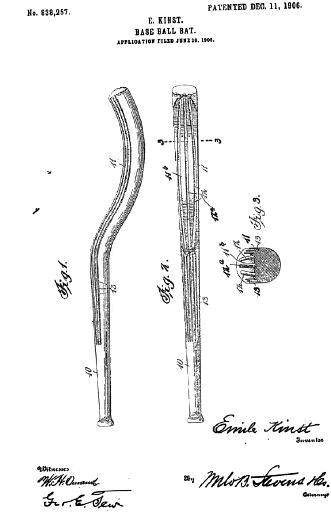You’ve been hearing all about torpedo bats of late, and with good reason. New equipment isn’t introduced to Major League Baseball often, but the torpedo bat represents a change in the design of a piece of equipment that’s been part of the game from the start: the baseball bat itself. The New York Yankees having themselves an offensive explosion against the Milwaukee Brewers on opening weekend certainly helped bring them into the spotlight, but big games from the likes of Elly De La Cruz helped keep it there.
The thing is, the torpedo design is not the first change to baseball bats. They didn’t just arrive on the scene in the 19th century looking like they do today — it took years and years, well over a century even, to get from the kind of bat the game started with to the one that Giancarlo Stanton holds in his hands today.
Let’s look back at the bats that have existed in MLB, however briefly, and think on what could even be coming next.
[Related: The secret behind the Yankees’ newfound power? Torpedo bats]
Banana bat
If you thought “torpedo bat” was fun to say, or that a bat shaped like a bowling pin was a little silly to look at, then you need to be introduced to the banana bat. Patented in 1890 by Emile Kinst, the banana bat is curved a bit like a banana, though not as pronounced, even if the patent image makes it look like Kinst was influenced by ancient Egyptian swords.

Kinst’s 1890 patent for a “base ball bat” that’s shaped a bit like a banana. (Image via public domain and Wikimedia)
Here’s what the banana bat actually looks like in real life:
Kinst’s idea was that the curve of the bat would create spin on a struck ball in a way that would make it difficult for fielders to handle it. It didn’t become the new sensation he’d hoped, though, but at least the Savannah Bananas can make jokes about literal banana bats now in this post-torpedo world.
The dream lives on, Emile Kinst. The dream lives on.
Mushroom bat
Food was the only way to make new bat types relatable in those olden days, so, following the banana bat, the next innovation was the mushroom bat. This one changed the knob of the bat to look even more like a mushroom, hence the name. The idea was that the weight distribution of the bat would be better with a tapered, thin handle and a thick, mushroom-shaped knob at the end, but the longer knob also meant a little less bat designed for the actual hitting part of the bat’s job. The mushroom bat isn’t the most well-known alteration to bat design, but you can buy a replica from the Baseball Hall of Fame’s shop, if you’re into that.
Wright & Ditson bat
If batters found success with one knob, imagine how much more they could have with two? That was the idea behind the Wright & Ditson Lajoie bat, which had a normal knob at the bottom of the bat, but then a second knob a few inches above that, for batters to still have a knob to utilize when they decided to choke up, or for separation between their hands on the handle of the bat.
These bats are sometimes found being auctioned off for thousands of dollars, such as this used model with the name “Lajoie,” after Hall of Famer Nap Lajoie, branded right onto the barrel, that Lelands sold.

An authentic “Lajoie” branded Wright & Ditson bat with two knobs, the second of which was referred to as a “shoulder.” (Photo by Lelands Auctions)
No-knob bat
This is jumping ahead to the future a bit, but the complete opposite of the Wright & Ditson “Lajoie” model with its two knobs is the one Mets’ second baseman Jeff McNeil uses. It has no knob at all! This is an older style that has almost vanished entirely from the league — as MLB.com pointed out in 2018 when McNeil was a rookie, Hall of Famer Roberto Clemente used to swing a knob-less bat, but today McNeil’s decision is just seen as a bit weird to players used to having a knob there.
The knob-less bat has a fascinating design, since it still does thicken up toward the bottom of the bat, but it remains smooth up and down the barrel instead of using the mushrooming design that’s standard, and has been so, since the idea was first introduced.
Axe bats
Axe bats aren’t ubiquitous by any means, but part of the reason you won’t see Dodgers’ star Mookie Betts switching to a torpedo bat just yet is due to his familiarity with — and success with — the axe bat. Former Philadelphia Phillies shortstop Jimmy Rollins was the first to utilize the axe bat, and former Red Sox second baseman Dustin Pedroia became its champion for a bit, with the idea being that it might help to keep him from all the hand and wrist injuries he’d suffered over the years.
Yahoo! Sports, covered the rise of the axe bat in 2015, and explained that Hall of Fame and hitting legend Ted Williams had compared swinging a bat to swinging an axe nearly half-a-century before in his book, The Science of Hitting. “Try it for yourself. Get a bat and swing it against a telephone pole. I do this with doubting young Washington players. Where is the wrist position at point of impact? Square and unbroken, that’s where, just as when you hit a tree with an ax.”
These are still in use, and while they didn’t take the entire league by storm as it looked like they could a decade ago, the axe bat might end up outlasting many of the adjusted knob designs of baseball’s past. That’s something to remember when it comes to the torpedo bat, as well: not everyone in the league has to use one for it to be a successful innovation, or useful for the players who do find success with one in hand.
Bottle bat
The torpedo bat is a new design, yes, but it’s not the first bat to decide that redistributing weight of the bat to where it could be best utilized was the right play. Heinie Groh used a “bottle” bat that looked like, well, a bottle. Perfectly named bat, really.
Groh’s career took place both immediately before and after Baseball’s Deadball era, and since the ball in that time was practically made out of rolled up socks and dreams, finding just the right bat to send it flying was a lot more common than it is today.
Changes in wood
It’s not just knobs and handles and barrels that have been adjusted over the years. Baseball bats have been made out of hickory — a dense, heavy wood that helps explain why the bats sluggers used in the earlier days of the game weighed as much as Dustin Pedroia did — and out of ash, until the availability of ash became a problem when the trees became endangered due to ash borers feeding on them.
Maple has been the standard for some time now, though, that switch brought its own issues. The wood was both light and strong, but because of the way the wood was grained — it’s slope-grain —, it also split into dangerous shards when they broke, to the point that MLB and the Major League Baseball Players Association had to make effective governing of the maple bat production process a subject of collective bargaining in 2008.
Maple might not be the end of the exploration of different wood types, either. Bamboo can be used alongside maple to make for a stronger composite bat, for example, and there are bats that are made only of bamboo that producers like Rawlings put out. Unlike with the kind of bats players are used to, these bamboo bats are made of multiple pieces of bamboo rather than from one tree, like maple or ash are. Like with maple bats becoming more popular after the success Barry Bonds found with them. However, all it takes is for someone to introduce the change — the axe bats weren’t approved for use until they were, either, which is how this all goes and the game gets to continue to evolve.
Want great stories delivered right to your inbox? Create or log in to your FOX Sports account, and follow leagues, teams and players to receive a personalized newsletter daily!

Get more from Major League Baseball Follow your favorites to get information about games, news and more














Leave a Reply